
Brian Wilson Aldiss was an English writer and anthology editor, best known for science fiction novels and short stories. His byline reads either Brian W. Aldiss or simply Brian Aldiss, except for occasional pseudonyms during the mid-1960s.

The Gunslinger is a fantasy novel by American author Stephen King. It is the first volume in the Dark Tower series.
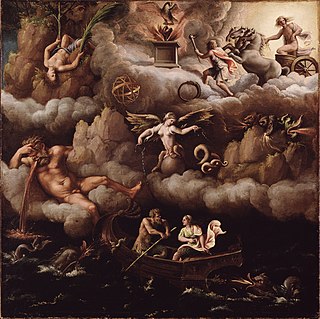
A monster is often a type of grotesque creature, whose appearance frightens and whose powers of destruction threaten the human world's social or moral order.
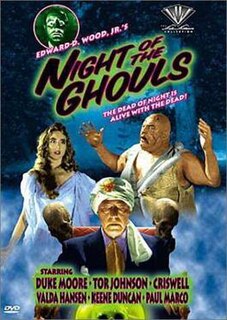
Night of the Ghouls is a horror film written and directed by Ed Wood. The film features some reoccurring cast members and characters from Bride of the Monster, including Tor Johnson reprising his role of Lobo and Paul Marco again playing the character of Kelton, while the Amazing Criswell plays himself in the frame story of the film. Another returning character is Police Captain Robbins of Homicide, although the character is played by Harvey B. Dunn in Bride, and by Johnny Carpenter in Night..
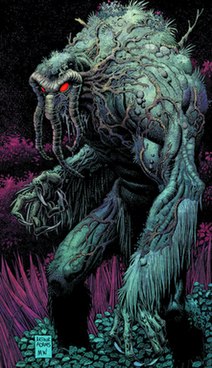
The Man-Thing is a fictional character appearing in American comic books published by Marvel Comics. Created by writers Stan Lee, Roy Thomas, and Gerry Conway and artist Gray Morrow, the character first appeared in Savage Tales #1, and went on to be featured in various titles and in his own series, including Adventure into Fear, which introduced the character Howard the Duck.

The Thief of Always is a novel by Clive Barker that was published in 1992. The book is a fable written for children, but intended to be read by adults as well. The book's cover was created by Barker and the book contains several black and white illustrations by the author.

Wintersmith is a comic fantasy novel by British writer Terry Pratchett, set in the Discworld and written with younger readers in mind. It is labelled a "Story of Discworld" to indicate its status as children's or young adult fiction, unlike most of the books in the Discworld series. Published on 21 September 2006, it is the third novel in the series to feature the character of Tiffany Aching. It received recognition as a 2007 Best Book for Young Adults from the American Library Association.

Fictional representations of the planet Venus have existed since the 19th century. Its impenetrable cloud cover gave science fiction writers free rein to speculate on conditions at its surface; all the more so when early observations showed that not only was it very similar in size to Earth, it possessed a substantial atmosphere. Closer to the Sun than Earth, the planet was frequently depicted as warmer, but still habitable by humans. The genre reached its peak between the 1930s and 1950s, at a time when science had revealed some aspects of Venus, but not yet the harsh reality of its surface conditions.

Elizabeth Hand is an American writer.

The Cat's Pajamas: Stories (2004) is a collection of short stories by Ray Bradbury. Its name of its title story comes from a phrase in English meaning a sought after and fancy thing. Another collection by the same name was published in the same year by fellow science fiction author James Morrow.
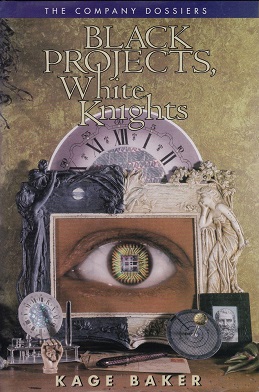
Black Projects, White Knights is a collection of short stories by American writer Kage Baker, published by small-press science fiction publisher Golden Gryphon Press, assembling various short stories set in the universe of The Company series, which comprises the bulk of her published fiction. Almost all of the stories contained within this volume have been published previously in the pages of Asimov's Science Fiction, with the remainder being previously unpublished. Note: not all of the Company stories extant at the time of publishing were collected into this volume.
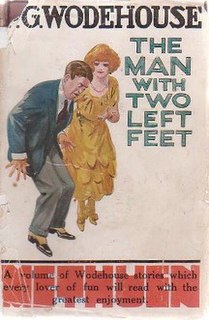
The Man with Two Left Feet, and Other Stories is a collection of short stories by British author P. G. Wodehouse, first published in the UK on 8 March 1917 by Methuen & Co., London, and in the US on 1 February 1933 by A. L. Burt and Co., New York. All the stories had previously appeared in periodicals, usually The Strand Magazine in the United Kingdom and The Red Book Magazine or The Saturday Evening Post in the United States.

The planet Jupiter, the largest planet in the solar system, is a popular backdrop for science fiction stories and films. Early works of science fiction used Jupiter itself as a location for stories, but modern science has shown that the planet has no solid surface one could land on and that its atmosphere, temperature, high gravity and intense radiation is hostile to human life. As a result, the Jovian system as a whole, including both the space around Jupiter and its very extensive system of moons, is a more common setting for science fiction.
The complete bibliography of Gordon R. Dickson.
Vampire Kisses is a series of books written by Ellen Schreiber. Vampire Kisses is about a 16-year-old girl named Raven Madison who is a goth misfit in her polo-wearing, ordinary, town. When an old abandoned mansion finally gets new residents, the rumors start to spread. Everyone in the small town, which Raven refers to as “Dullsville”, believes that the new neighbors are actually secret bloodthirsty vampires. Even Raven, who has always loved vampires since she was little, believes the rumors. But one day, she encounters the attractive yet mysterious Alexander Sterling that lives in the mansion, and feels like he is the only person that actually understands her. The two very quickly fall in love, but still the question remains; are the Sterlings really vampires?
"It" is a horror short story by American writer Theodore Sturgeon, first published in Unknown of August 1940. The story deals with a plant monster that is ultimately revealed to have formed around a human skeleton, specifically that of Roger Kirk, in a swamp. P. Schuyler Miller described "It" as "probably the most unforgettable story ever published in Unknown. "
The fictional character the Swamp Thing has appeared in five American comic book series to date, including several specials, and has crossed over into other DC Comics titles. The series found immense popularity upon its 1970s debut and during the mid-late 1980s under Alan Moore, Stephen Bissette, and John Totleben. These eras were met with high critical praise and numerous awards. However, over the years, the Swamp Thing comics have suffered from low sales, which have resulted in numerous series cancellations and revivals.

"The Blue Giraffe" is a science fiction story on the concept of mutation by American writer L. Sprague de Camp. It was first published in the magazine Astounding Science-Fiction for August, 1939. It first appeared in book form in the anthology Adventures in Time and Space ; it later appeared in the anthologies World of Wonder, The Science Fiction Bestiary, Androids, Time Machines and Blue Giraffes, Isaac Asimov Presents the Great Science Fiction Stories: Volume 1, 1939, Isaac Asimov Presents The Golden Years of Science Fiction, and An Anthropomorphic Century. The story has been translated into Italian, French and German.

Carlo Valli is an Italian actor and voice actor who is best known as the official dubbing voice for Robin Williams.















